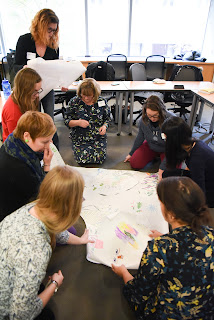 |
| Symposium attendees worked as a group to make a finished art piece |
|
The symposium aimed to bring together “arts and health professionals, students and community members in conversation at the intersection(s) of trauma-informed practice and community-engaged art.” The event was open to the public, and was attended by individuals from fields including medical, mental health, pharmaceuticals, education, and community non-profits.
Stevie delivered a 5-minute presentation and a breakout workshop. Her presentation focused on the role of metaphor and non-verbal communication as demonstrated through her work with the Bhutanese Elders Project in Refugee Project in 2014.
 |
| Attendees working to complete their group art project |
The day also included a 2-hour keynote presentation by Sandra Bloom MD, Drexel University Dornsife School of Public Health. Dr. Bloom discussed the trauma through a neurobiological lens and the important role that art can play in trauma treatment by accessing the right hemisphere of the brain. Other breakout presenters included Mural Arts Philadelphia's Porch Light Program, The Village of Arts and Humanities, and Warrior Writers.
The brief presentations were followed by half-hour breakout sessions focusing on the presenters’ speeches more in-depth. For her breakout Stevie engaged attendees in an art experiential meant to exemplify the power of non-verbal communication and encourage qualities that constitute a healthy community, such as collaboration, finding common ground, and the sharing of resources. The group began work individually and then moved to working together towards a common goal (the finished artwork, a giant puzzle). After the attendees finished the art experiential, they were invited to process the experience as a group, and to apply what they had learned to their own professional work. Some of the discussion included exploring the power of art to bring together in a short period of time, the relief that some experienced by working in silence, and metaphors that arose from the artwork and the experience as a whole.
The day concluded with a lunch provided by Jefferson followed by a panel discussion with professionals from Jefferson and Wests Philadelphia Cultural Alliance, which touched on intersectionality in the arts and social justice and other related topics.
 |
| Detail of the completed art project, with drawings from all attendees in the breakout session |

Comments
Post a Comment